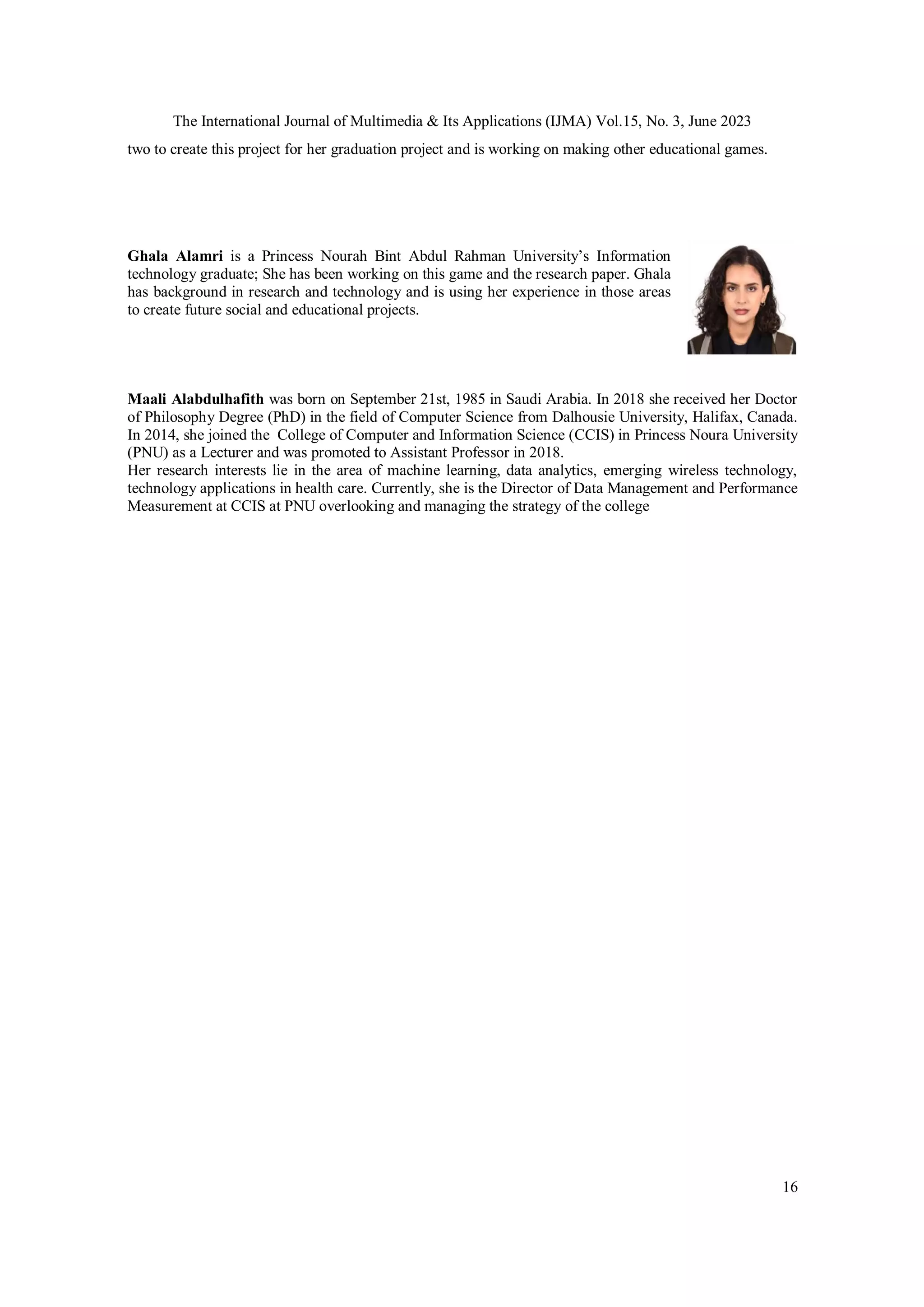The document presents a study on an interactive virtual reality game designed to educate neurotypical individuals about autism spectrum disorder (ASD) and improve communication with autistic people. It highlights the social and communication challenges faced by individuals with ASD, emphasizing the need for neurotypical awareness and understanding to foster better interactions. The game includes scenarios that allow players to experience situations from the autistic perspective, enhancing empathy and awareness in social environments.
![The International Journal of Multimedia & Its Applications (IJMA) Vol.15, No. 3, June 2023
DOI:10.5121/ijma.2023.15301 1
ALTRUISTIC
ASD (AUTISM SPECTRUM DISORDER) VIRTUAL
REALITY GAME
Taraf Alshalan, Ghala Alamri and Maali Alabullhafith
College of Computer and Information Science at Princess Norah University, Riyadh,
Saudi Arabia.
ABSTRACT
Autism spectrum disorder is a developmental disability that can cause significant social, communication
and behavioural challenges. Parents of children on the spectrum find it difficult for their kids to
communicate with them and other people, which makes it challenging for social interactions. Researchers
have introduced different solutions such as Therapy Robot that Teaches Social Skills to Children with
Autism. Additionally, Virtual reality was used to teach emotional and social skills to children with autism
spectrum disorder. However, these solutions focus only on the person on the spectrum, neglecting the fact
that the social challenges that people on the spectrum face are partly due to the lack of understanding on
the neurotypicals' end. In this study, the solution introduced focuses on the neurotypical perspective; An
advanced and interactive intelligent technology that can educate neurotypical people on how to
communicate with people on the spectrum in different scenarios and environments. It also allows the
learner to see the consequences of the different interactions from the point of view of a person on the
spectrum, be aware of their actions, and fully engage in the scenarios through Virtual Reality (VR). Virtual
Reality is a technology that simulates experiences that can be similar to the real world. The project aim
was achieved by implementing a storyline game that is VR-based.
KEYWORDS
Autism, Neurodivergent, Neurotypical, Virtual Reality, Communicating on the spectrum.
1. INTRODUCTION
Autism, or autism spectrum disorder (ASD), refers to a broad range of conditions characterized
by challenges with social skills, repetitive behaviours, speech, and nonverbal communication [1].
autistic people find it hard communicating in general, and recent studies have shown that people
on the spectrum prefer only contacting other autistic people [2], which may be due to the fact that
neurotypical people do not have enough knowledge on how to communicate with people on the
spectrum. The aim of this project is to make people with the least interaction with people on the
spectrum experience situations from an autistic person’s perspective to raise awareness about
autism. This is achieved by allowing the learner to view how this neurological condition affects
the integration of individuals living with it. This is done in an effort to make the learner
understand the way people on the spectrum think by projecting the challenges they face daily,
such as:
-social communication challenges, where adults and children with autism have difficulties with
verbal and non-verbal communication for example they may not understand or appropriately use
spoken language (around a third of people with autism are non-verbal), gestures, facial
expressions and expressions not meant to be taken literally.](https://image.slidesharecdn.com/15323ijma01-230712110130-3fc1d0f1/75/Altruistic-ASD-Autism-Spectrum-Disorder-Virtual-Reality-Game-1-2048.jpg)
![The International Journal of Multimedia & Its Applications (IJMA) Vol.15, No. 3, June 2023
2
-additional social challenges: Including difficulty with recognizing emotions and intentions in
others, expressing emotions, feeling overwhelmed in social situations, taking turns in
conversations, and gauging personal space (appropriate distance between people).
lack of awareness and understanding of an autistic person’s behaviour affects them in many ways
psychologically and physically when a person misunderstands their behaviour, hence,
Researchers have focused on solutions for ASD, and ignored the neurotypicals who interact with
them. Therefore, there is a lack of studies that teaches neurotypicals on how to communicate and
interact with people on the spectrum in our everyday life rather than the other way around. take
on a futuristic look by incorporating innovative technology into an educational setting to address
the complexity in interacting and communicating with people on the autism spectrum. The game
was created with the assistance of specialists in that field to determine what would have been the
best way for a neurotypical person to handle the different situations making an impact socially.
2. RELATED WORK
There is no doubt that technology has completely changed our world. It has given us unlimited
access to information and communication while removing the need for physical, social
interaction. Technology has helped kids with Autism learn and develop skills like never before.
However, this related work covers solutions that have used technology to enhance a life of people
with autism.
2.1. Therapy Robot Teaches Social Skills to Children with Autism
For some children with autism, interacting with other people can be an uncomfortable, mystifying
experience. Feeling overwhelmed with face-to-face interaction, such children may find it difficult
to focus their attention and learn social skills from their teachers and therapists—the very people
charged with helping them learn to socially adapt.
What these children need, say some researchers, is a robot: a cute, tech-based intermediary, with a
body, that can teach them how to interact with their fellow humans more comfortably [3].
It has so many positive impacts such as:
• Feeling at ease with a robot, these children are better able to focus their attention on a
curriculum presented together by the robot and a human therapist.
• with a robot in the room, children tend to interact more with human therapists, according
to feedback the company received during its research, says Nazari Khorram. "The robot
has the ability to create a triangular interaction between the human therapist, the robot,
and the child,” she says. “Immediately, the child starts interacting with the educator or
therapist to ask questions about the robot or give feedback about its behaviour.”
We asked Nazari Khurram if it’s possible that pairing robots with children with autism could
move them further away from people, and closer to technology. “That’s one of the fears that
people have,” she says. “But in practice, in our studies and based on the feedback of our users, the
interaction between the children and the therapists improves.[3]
2.2. Upgraded Google Glass Helps Autistic Kids “see” Emotions
When a face is recognized, the head-up display's boundary turns green, and the display identifies
the facial emotion with an emoticon, emoji, or written text. Users can alternatively opt for an](https://image.slidesharecdn.com/15323ijma01-230712110130-3fc1d0f1/75/Altruistic-ASD-Autism-Spectrum-Disorder-Virtual-Reality-Game-2-2048.jpg)
![The International Journal of Multimedia & Its Applications (IJMA) Vol.15, No. 3, June 2023
3
auditory cue a voice defining the emotion from the bone-conducting speaker included into the
glasses, which transmits sound waves through the skull to the inner ear. Happiness, anger,
surprise, sadness, fear, disgust, and contempt are among the seven facial expressions recognized
by the system, which we renamed "meh" to make them more child friendly. Children are
supposed to quickly learn how to detect the feelings of their social partners and then stop wearing
glasses once they have achieved social confidence [4].
2.3. Using Virtual Reality to Train Emotional and Social Skills in Children with
Autism Spectrum Disorder
In the beginning mentioned that training became popular with new emerging technology,
focusing on virtual reality (VR) to help children with autism spectrum disorder (ASD) with social
skills and developing communication with outside world by an environment that is managed and
supervised to make them feel safe and practice skills repetitively. The Centre for innovative
applications of internet and multimedia technologies (AIMTech Center) at university of Hong
Kong developed a VR-enabled training program to examine efficacy on emotional and social
skills with six VR scenarios with typical daily lives of children in Hong Kong, 94 children from
mainstream primary schools in Hong Kong completed the study and 72 children were included in
the analysis. Emerging modern technology offers solutions for different cases in our time, taking
for example treating depression with computerized and internet-based treatment was found to be
effective with therapist support, with the virtual reality (VR) technology increasing studies and
application lately been increasing based on training and therapy, the environment of virtual reality
(VR) provides a whole experience of situations [5].
Taking the actual definition of ASD being a developmental disorder characterized by persistent
impairment in social communication and patterns of repetitive behaviours, it comes the part
where using VR is useful to simulate different many social situations for autistic people to
practice on and develop social skills easily better than social stories being
presented on paper or in a recording or as visual representation where it just includes observing
and not interacting.
For example, there is situations that cannot be presented in real life and practiced for how
dangerous it is, like teaching children to cross a red light so by that it can be programmed into
VRE, to provide a safe environment.[5]
The actual method performed on children with ASD and their teachers developed by the Centre
for Innovative Applications of Internet and Multimedia Technologies (AIMTech Centre) at City
University of Hong Kong has developed a VR training program to help children with ASD, called
the (CAVE) cave automatic virtual environment that allows the interaction of different scenarios
based on real life situations, the training include a group of children 3 to 4 to a briefing session
covering to go back on previous skills taken to prepare for the actual VR training. Then, start
every child individually on the CAVE technology and navigate through the VR technology
supervised by the trainer, the session lasts one hour then followed by briefing discussion of
learned skills to perform in real life, seasons are divided into six including a relaxation scenario,
four training scenarios and one consolidation scenario.
All scenarios designed to match real life of typical primary school children in Hong Kong.[5]
Selected primary school children with ASD participated in the study, where parents and children
were invited to an information session for the parents to consent over their children participating
in the study voluntary and with the right to withdraw at any time.[5] At last, 94 children
completed the study, and 72 children were included in the analysis after filtering for age. There](https://image.slidesharecdn.com/15323ijma01-230712110130-3fc1d0f1/75/Altruistic-ASD-Autism-Spectrum-Disorder-Virtual-Reality-Game-3-2048.jpg)
![The International Journal of Multimedia & Its Applications (IJMA) Vol.15, No. 3, June 2023
4
were 64 boys (88.9%) and 8 girls (11.1%) with a mean age of106.3 months (SD = 13.53; Table
1). Children with documentation of intellectual disability were excluded from this study. The
children have all received a diagnosis of ASD by Child Assessment Service in Hong Kong or via
private practice. A waitlist control design was adopted.[5]
The feedback gathered from parent and teachers was positive as parents expressed that their
children were more communicating with their surrounding environment of family and
neighbours, while teachers reported that their students are making more friends and engaging in
two-way conversations.[5]
In despite difficulties faced in beginning where children refused to wear goggles due to bad past
experiences for example at the 3d movies or just being uncertain but with the support of the
trainers after a couple of sessions children were able to wear it comfortably and went through the
sessions with understand of the audio and visual information in the VR system, while the briefing
sessions before the actual experience came in great help to the trainers facing the children
emotional and behavioural issues that may arise during training.[5]
2.4. Use of Telehealth for Facilitating the Diagnostic Assessment of Autism
Spectrum Disorder (ASD)
It can provide assistance and support to people who have specific health and well-being needs.
Telehealth is defined as a "system that allows people to get professional services and support
from a distance." [6]
Telehealth may have advantages over traditional face-to-face approaches, such as enhancing
access to healthcare services, particularly for people and families living in rural and underserved
areas.[6]
Several studies suggested that the use of telehealth programs, combining web-based instructional
content with weekly video-conferencing coaching sessions may support parental learning and
improve a child’s social communication skills, Parents also indicated that such systems were
effective, acceptable, and usable.[6]
The position of telehealth in the field of ASD is small but growing. Telehealth approaches have
recently been explored as a way of supporting the delivery of a range of services for people with
ASD and their families.
Telehealth might be used to improve individuals’ access to behavioural intervention services.
Several studies used telehealth to coach parents of children with ASD to conduct behavioural
assessments such as functional analyses (FA), functional communication training (FCT) via the
use of videoconferencing, either parents and their child located at a regional clinic, home, or
school.
The findings suggested that parents can successfully conduct FA and FCT through telehealth
when behaviour analysts offer consultation remotely. It has also been found reductions in
problem behaviour of children. For example, Wacker et al. found the average reduction in
problem behaviour was 93.5%. Similarly, Lindgren et al. revealed that problem behaviour was
decreased by an average of 90%. It has also been demonstrated the preliminary efficacy of
telehealth- delivered parent mediated interventions that are intended to increase parent knowledge
and the use of ASD behavioural intervention strategies with the child in their daily life. Several
studies suggested that use of telehealth programs, combining web-based instructional content
with weekly video-conferencing coaching sessions may support parental learning and improve](https://image.slidesharecdn.com/15323ijma01-230712110130-3fc1d0f1/75/Altruistic-ASD-Autism-Spectrum-Disorder-Virtual-Reality-Game-4-2048.jpg)
![The International Journal of Multimedia & Its Applications (IJMA) Vol.15, No. 3, June 2023
5
child’s social communication skills. Parents also indicated that such systems were effective,
acceptable, and usable.[6]
3. RESEARCH APPROACH
Phase 1: Defining the Scenarios
The game was created with the assistance of specialists in that field so that we can educate
neurotypical people on how to interact properly with people on the spectrum. The scenarios will
be based on real life told by people on the spectrum and how it affected them and how the
situation could have been avoided if things were different.
Our advantage is that we take a scenario that occurred in real life with a person on the spectrum
and present it to a specialist to determine what would have been the best way for a neurotypical
person to handle the situation and educate people so that the social environment can be more
accepting and welcoming of people on the spectrum. Our project will make an impact socially
because it will raise awareness and help people deal with different situations connecting with
people on the spectrum.
Phase 2: Designing and Developing the Video Game
We developed the game using the Unreal engine. The game is a storyline that teaches the users
how to interact with a person on the spectrum as they go through scenarios and choose what
action to make depending on their perception of what is the right way to act with a person with
ASD's.
The main idea of this game is using the knowledge the average person has about people on the
spectrum to help them choose the correct action to make and witness the consequences of it.
The game aims toward raising knowledge to those who are not aware of the right way to behave
with an autistic person, where we saw the neglect on this area and the main focus and display of
technology is on autistic people, employing VR technology to mimic a real life situation with an
autistic person and from the point of view of an autistic person benefits both sides, where it will
have a positive reflect on autistic people making them feel understood and ease the
communication at the same time raise the level of knowledge and awareness in neurotypical
people.
The game starts with the main menu, then the first level scenario will play. The first level is an
introduction to the game play and structure. the level starts in a classroom, the teacher asks the
students to take a seat and start working on the in-class assignment with their classmates.
The player walks to the classmate and faces with a question “The teacher asked us to pair up, do
you want to work together?” The classmate is not responding; therefore, the player must choose
between two choices. The first choice is “Ask to join by pointing to the computer”, The second
choice is “Shout Their name”.
Each choice has its consequences if it is the correct choice the player will go to the next level, if it
is the wrong choice the Player will see the point of view of the classmate. In the point of view in
the first scenario the player sees the interaction from the classmate's perspective, it starts when the
classmate was hyper focused on a green frog and did not hear the player shouting. The classmate
gets triggered from the loud shouting and the interaction starts an episode, which the player sees.](https://image.slidesharecdn.com/15323ijma01-230712110130-3fc1d0f1/75/Altruistic-ASD-Autism-Spectrum-Disorder-Virtual-Reality-Game-5-2048.jpg)

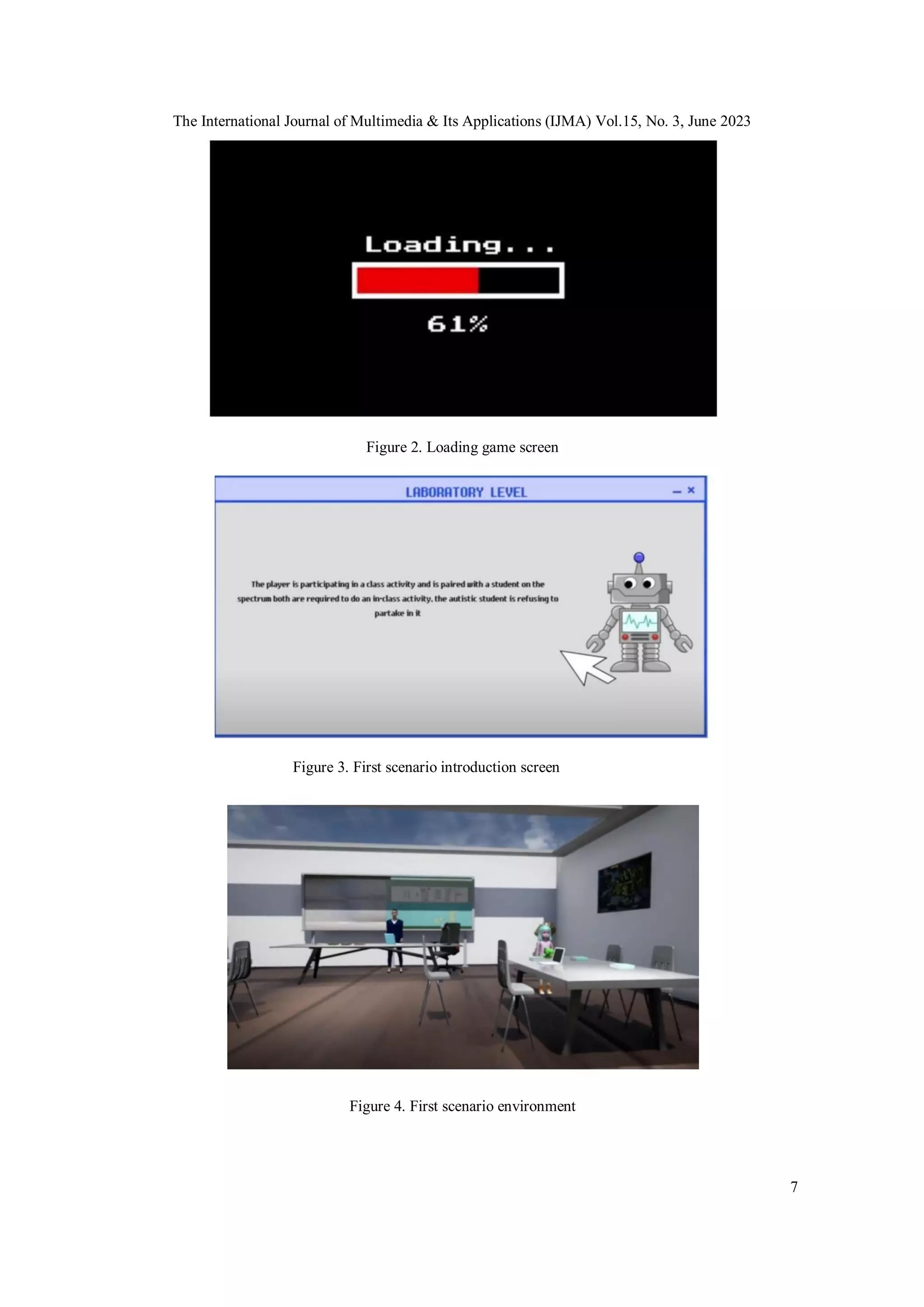
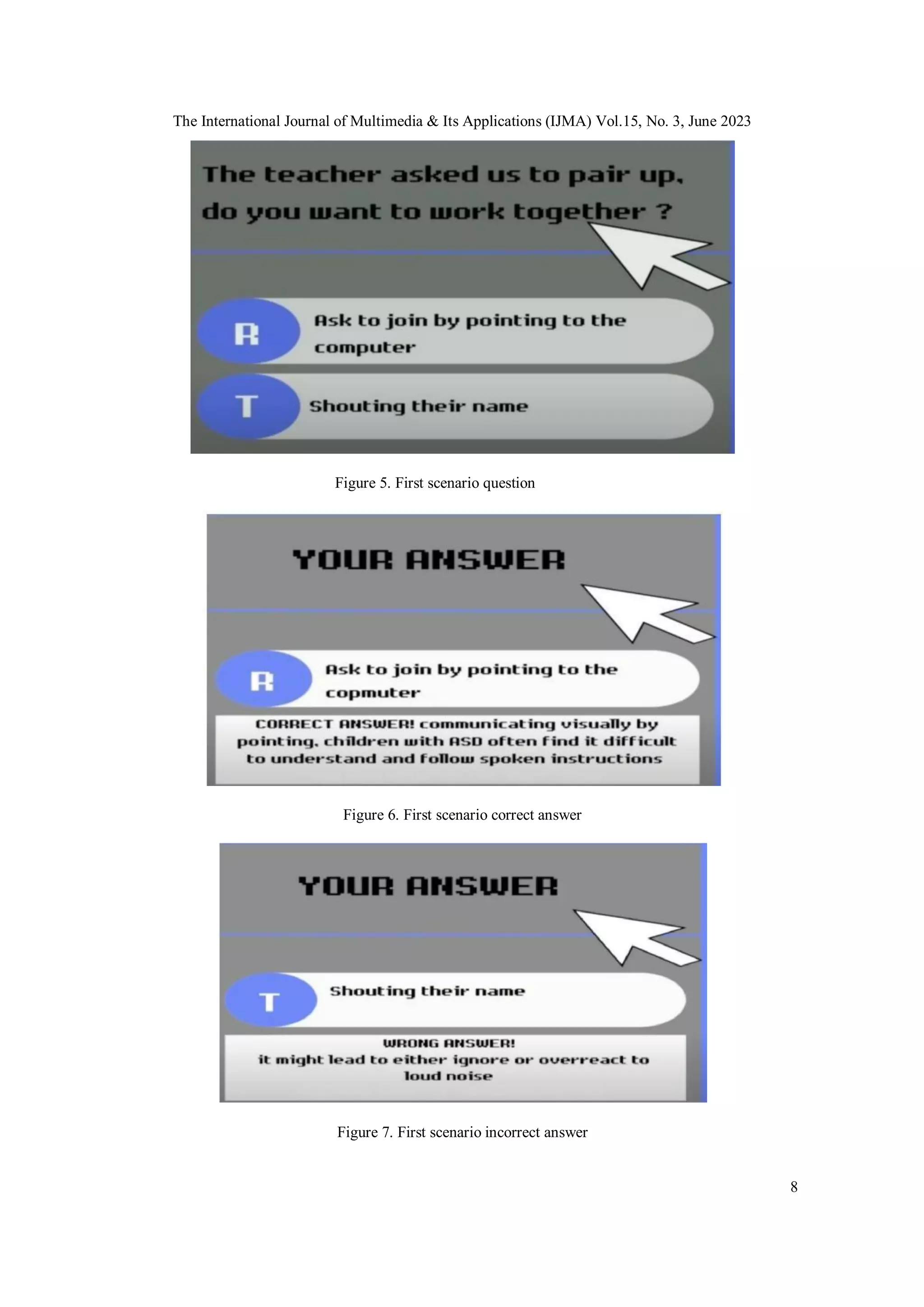
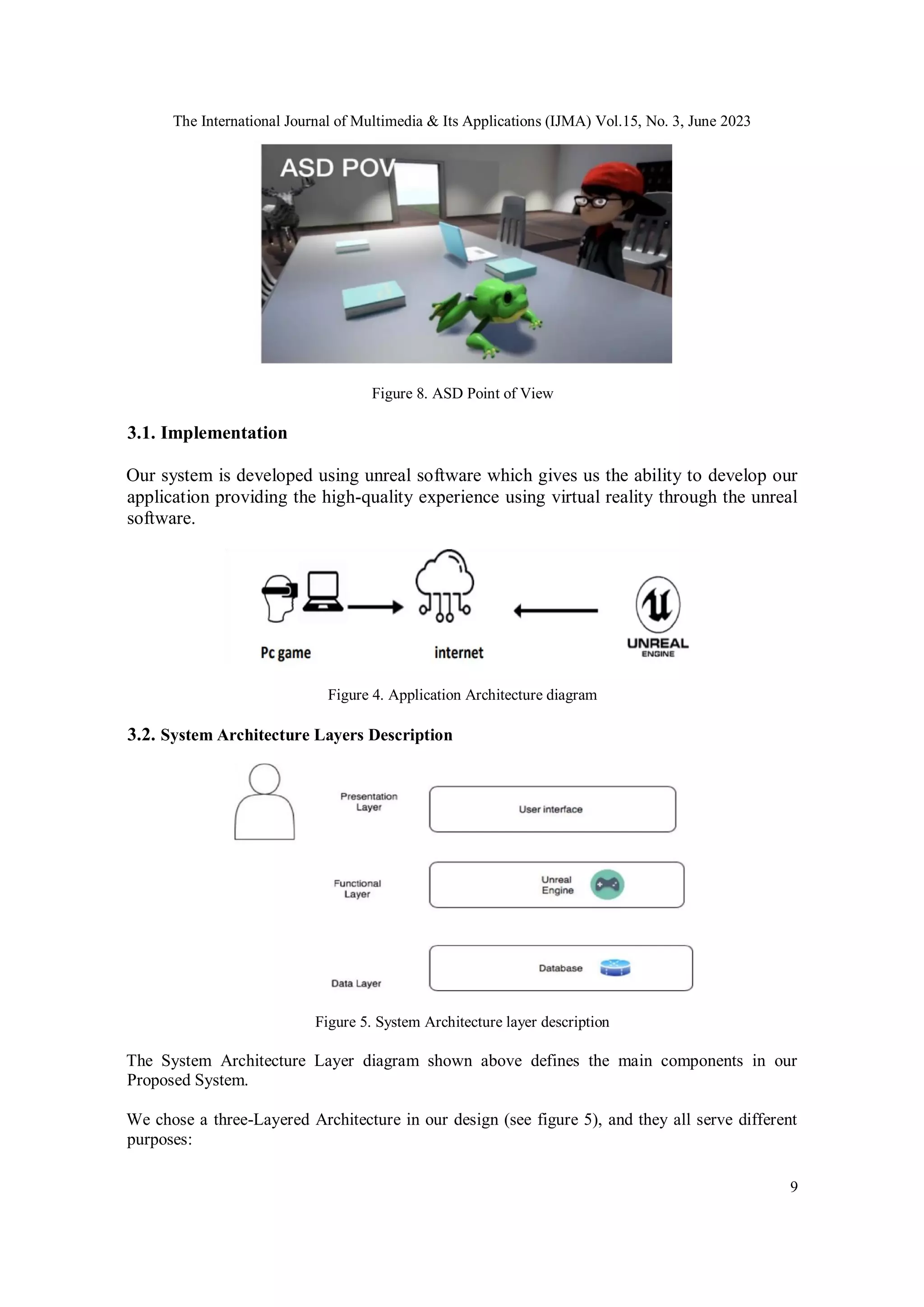
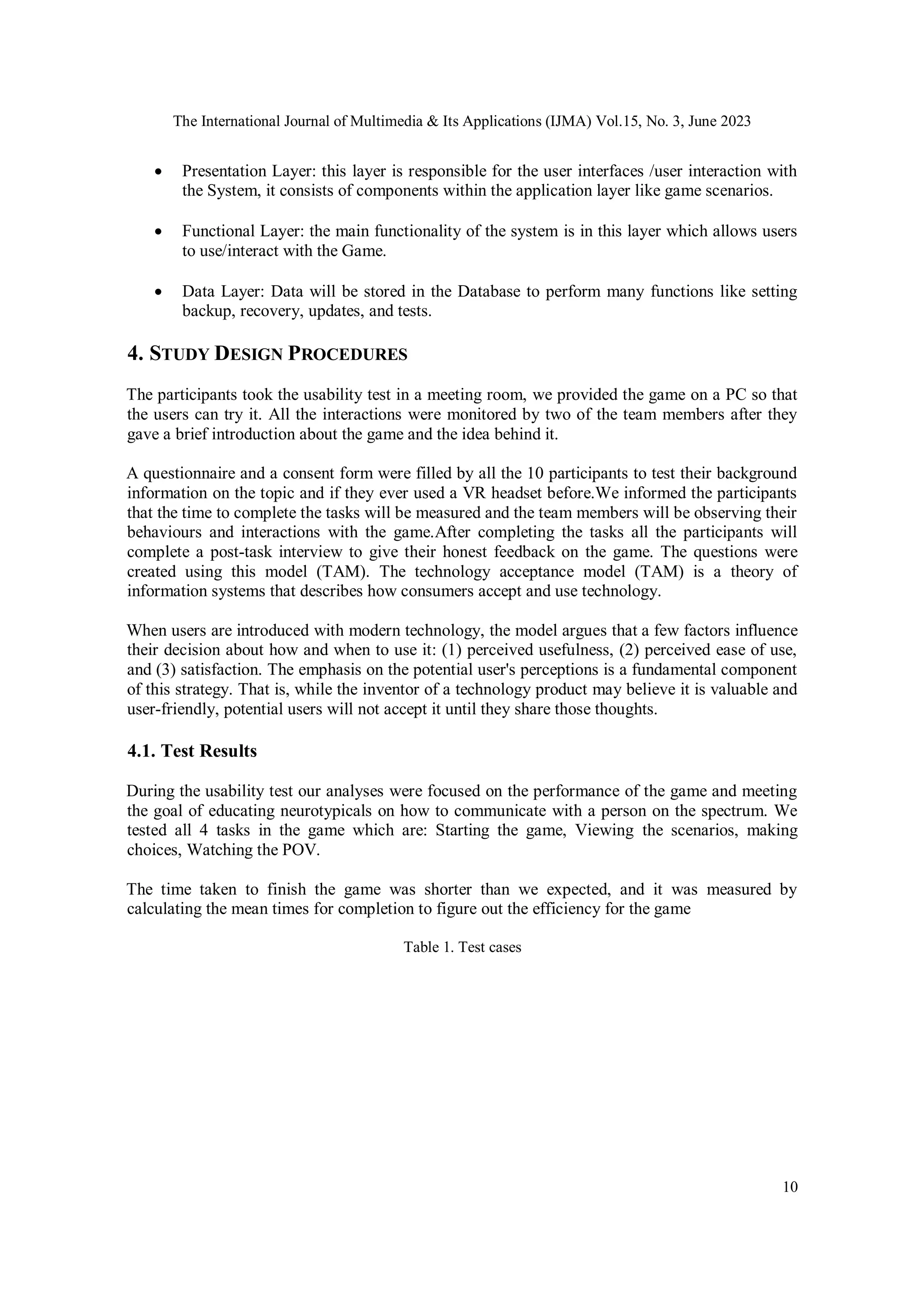
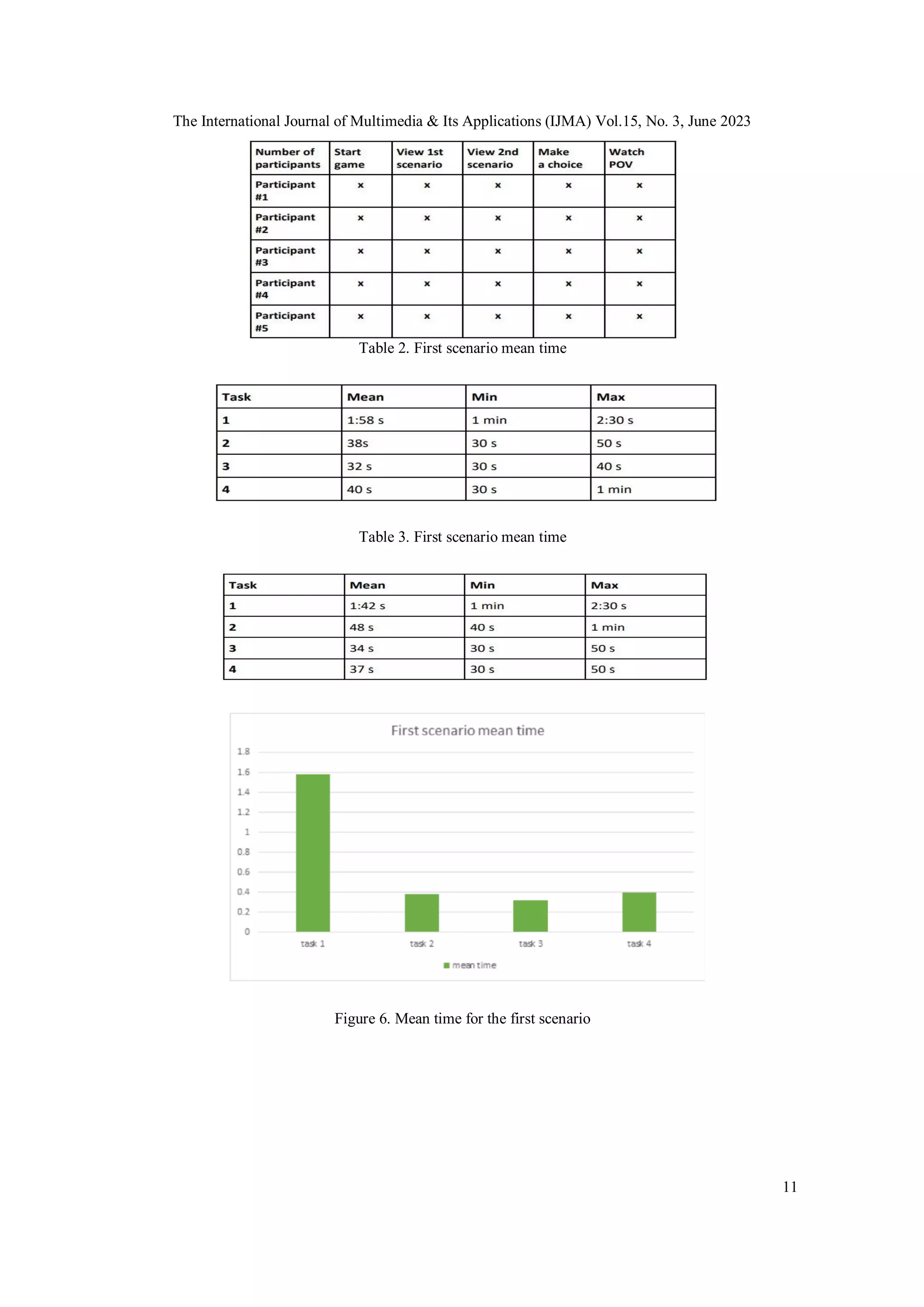
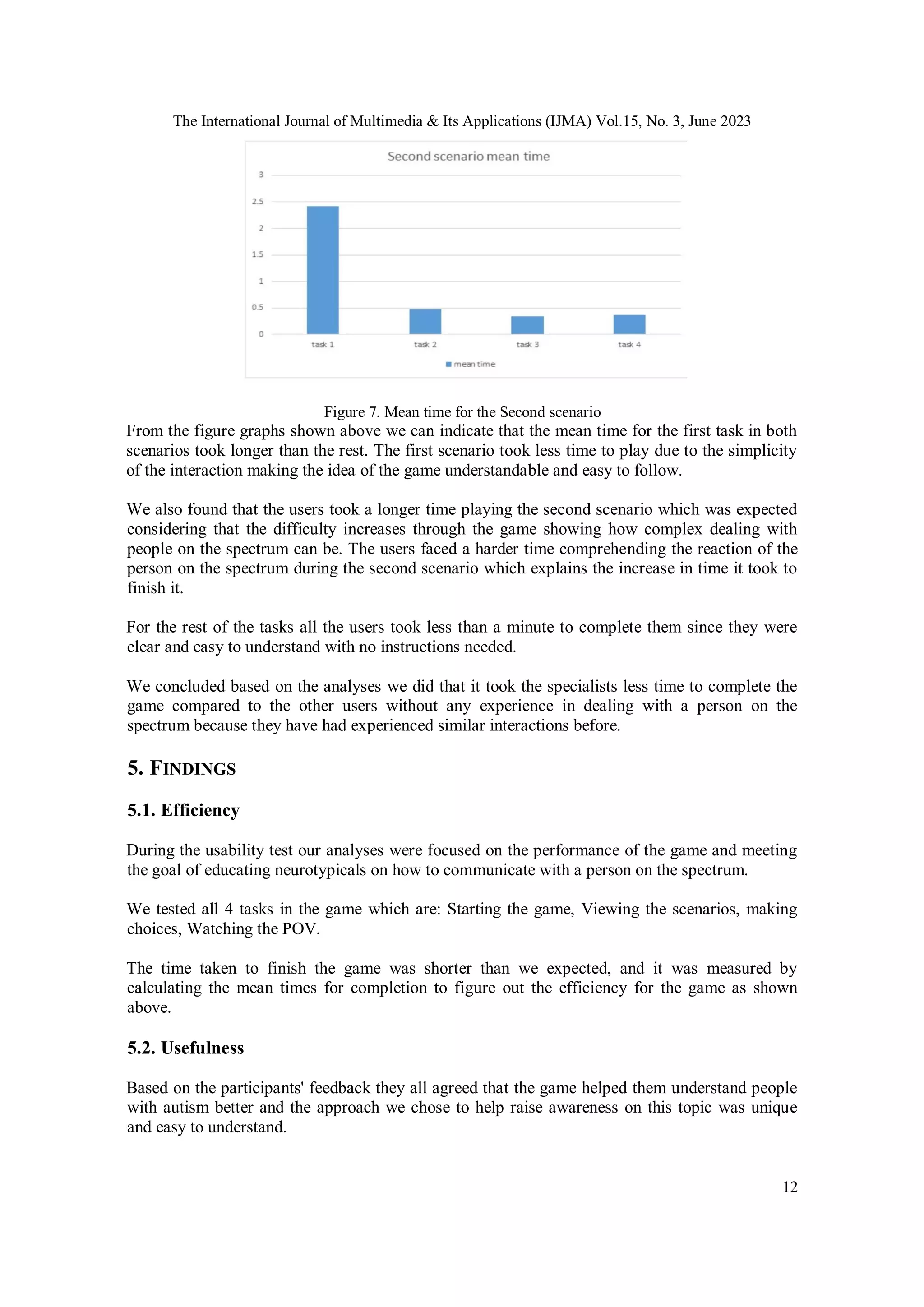

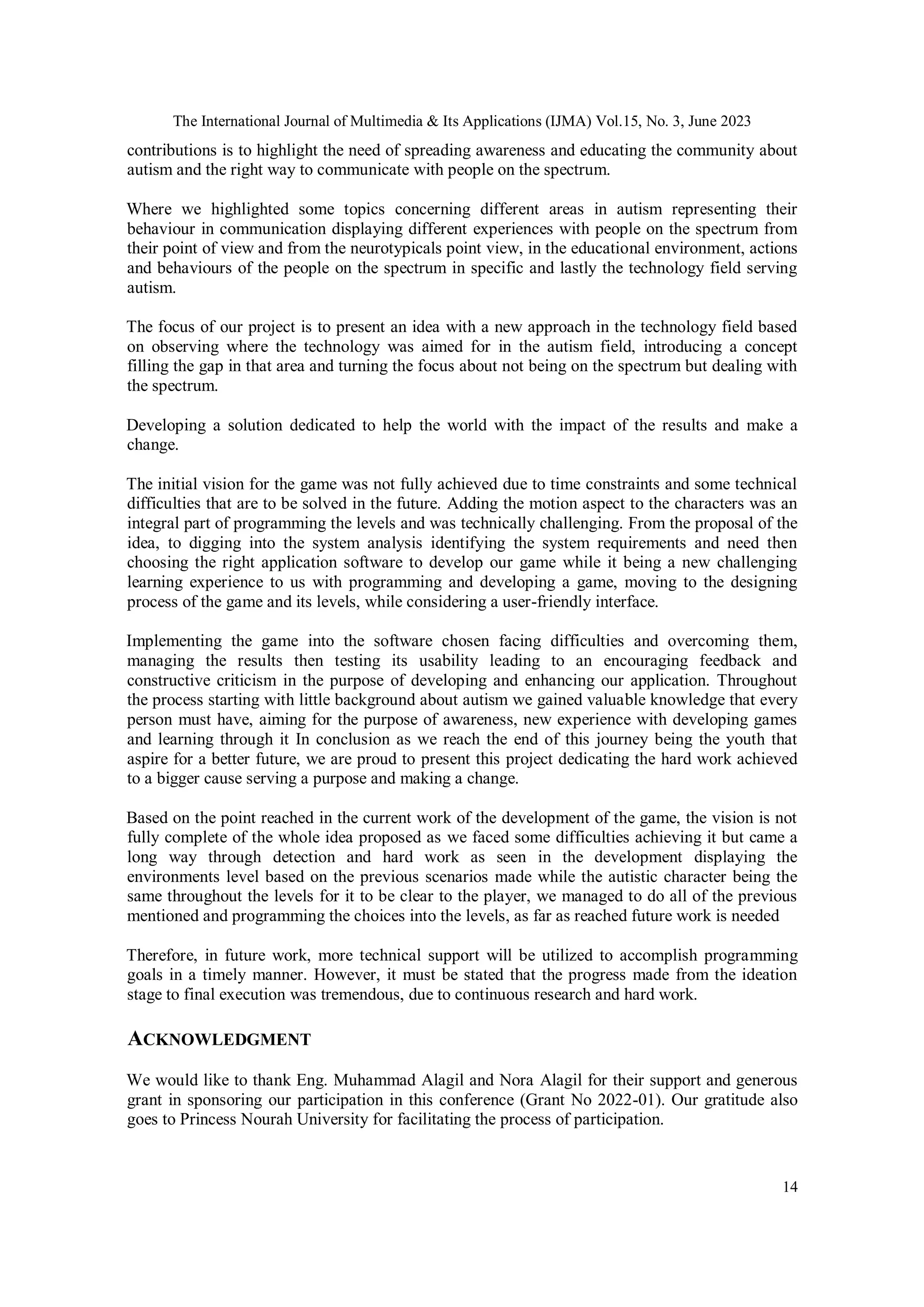
![The International Journal of Multimedia & Its Applications (IJMA) Vol.15, No. 3, June 2023
15
REFERENCES
[1] A. Speaks, “Autism - What is Autism?,” The National Autistic Society, vol. 17, no. 269425, 2011.
[2] C. J. Crompton, K. DeBrabander, B. Heasman, D. Milton, and N. J. Sasson, “Double Empathy: Why
Autistic People Are Often Misunderstood,” Front Young Minds, vol. 9, 2021, doi:
10.3389/frym.2021.554875.
[3] K. D. Bartl Pokorny et al., “Robot-Based Intervention for Children with Autism Spectrum Disorder:
A Systematic Literature Review,”
[4] A. Nag et al., “Toward continuous social phenotyping: Analyzing gaze patterns in an emotion
recognition task for children with autism through wearable smart glasses,” J Med Internet Res, vol.
22, no. 4, 2020, doi: 10.2196/13810.
[5] S. N. V. Yuan and H. H. S. Ip, “Using virtual reality to train emotional and social skills in children
with autism spectrum disorder,” London J Prim Care (Abingdon), vol. 10, no. 4, 2018, doi:
10.1080/17571472.2018.1483000.
[6] "Social Communication | Children's Minnesota", Children's Minnesota, 2021. [Online]. Available:
https://www.childrensmn.org/services/care-specialtiesdepartments/physicalrehabilitation/social-
communication/.
[7] "Pyramid Educational Consultants UK", Pyramid Educational Consultants UK, 2021. [Online].
Available: https://pecs-unitedkingdom.com/.
[8] Uou.ac.in, 2021. [Online]. Available: https://www.uou.ac.in/sites/default/files/slm/BHMAECC-
II.pdf.
[9] "Autism Spectrum Disorder: Communication Problems in Children", NIDCD, 2021. [Online].
Available: https://www.nidcd.nih.gov/health/autism-spectrumdisordercommunication-problems-
children.
[10] P. Meharwade, H. Nookala, S. Kajjari, P. Malavalli, S. Hugar and C. Uppin, "Bridging the
communication gap in autistic children, one picture at a time".
[11] "Double Empathy: Why Autistic People Are Often Misunderstood", Core.ac.uk, 2021. [Online].
Available: https://core.ac.uk/reader/427321197.
[12] "Developing and maintaining a relationship", Autism.org.uk, 2021. [Online]. Available:
https://www.autism.org.uk/advice-and-guidance/professionalpractice/maintainingrelationships.
[13] E. Cage, J. Di Monaco and V. Newell, "Experiences of Autism Acceptance and Mental Health in
Autistic Adults", 2021. .
[14] K. Gillespie-Lynch, S. Kapp, P. Brooks, J. Pickens and B. Schwartzman, "Whose Expertise Is It?
Evidence for Autistic Adults as Critical Autism Experts", 2021. .
[15] M. Hollocks, J. Lerh, I. Magiati, R. Meiser-Stedman and T. Brugha, "Anxiety and depression in
adults with autism spectrum disorder: a systematic review and metaanalysis", 2021. .
[16] "Excluded from school: Autistic students’ experiences of school exclusion and subsequent re-
integration into school - Janina Brede, Anna Remington, Lorcan Kenny, Katy Warren, Elizabeth
Pellicano, 2017", SAGE Journals, 2021. [Online]. Available:
https://journals.sagepub.com/doi/full/10.1177/2396941517737511.
[17] Files.eric.ed.gov, 2021. [Online]. https://files.eric.ed.gov/fulltext/EJ1137060.pdf.
[19] Good…, T., 2021. Technology and Autism: The Good and Bad - Eden II Programs. [online] Eden II
Programs.
[20] IEEE Spectrum. 2021. Therapy Robot Teaches Social Skills to Children With Autism. [online]
[21] IEEE Spectrum. 2021. Upgraded Google Glass Helps Autistic Kids “See” Emotions. [online]
[22] Healio.com. 2021. DNA testing may predict ASD in siblings of individuals with the disorder.
[online]
[23] Alfuraydan, M., Croxall, J., Hurt, L., Kerr, M. and Brophy, S., 2021. Use of telehealth for
facilitating the diagnostic assessment of Autism Spectrum Disorder (ASD): A scoping review.
AUTHORS
Taraf Alshalan is a Princess Nourah Bint Abdul Rahman University’s graduate; she
has been working on this project and working on publishing the game. Taraf has
background in programming games and innovate thinking. Therefore, combined the](https://image.slidesharecdn.com/15323ijma01-230712110130-3fc1d0f1/75/Altruistic-ASD-Autism-Spectrum-Disorder-Virtual-Reality-Game-15-2048.jpg)
